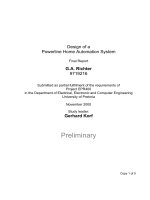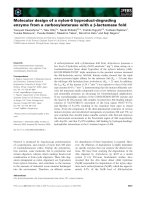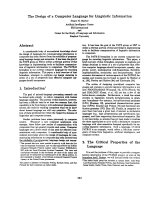Design of a compact triple band fractal planar inverted F antennafor handheld application
Bạn đang xem bản rút gọn của tài liệu. Xem và tải ngay bản đầy đủ của tài liệu tại đây (580.4 KB, 8 trang )
Electronics and Automation
DESIGN OF A COMPACT TRIPLE-BAND FRACTAL PLANAR
INVERTED F ANTENNAFOR HANDHELD APPLICATION
Duong Thi Thanh Tu1,2*, Nguyen Ngoc Tu1, Vu Van Yem2
Abstract:In this paper, a novel Fractal PIFA antenna for triple-band is
presented. The proposed antenna is based on the self affinity and lengthen shorting
pin of PIFA structure. The combining design of the F-PIFA antenna is optimized
and validated via simulation using CST-MW Studio as well as measurement. The
measured result is well in agreement tothe simulated result. Being on the FR4
substrate with the height of 1.6mm, the antenna getsa compact size with patch
dimension of 9.36x9.68mm2that is quite suitable for handheld terminals.The
proposed F-PIFA antenna operates at 2.6GHz, 5.0GHz and 7.3GHz with large
bandwidth of 10.55%, 25% and 5% respectively. All leads to the meet for
mobilebroadband services: LTE, Wi-Fi and X-band of Satellite on each handle
mobile equipment.
Keywords:PIFA,F-PIFA, Fractal, Triple band.
1. INTRODUCTION
Recently, the wireless communication system has advanced incredibly, especially in
mobile phone system. The dimensions of end used equipment is not only more and more
decrease but also the number of internal antennas in one terminal increase rapidly [1-2].
These require that internal antennas must be compacted to used practical mobile handsets
and have multiband for multi technologies. In last three decades, Planar Inverted F
Antenna (PIFA) has emerged as one of the most promising candidate for satisfying above
demands [3-4]. However, one of the limitations of PIFA antenna is narrow bandwidth
which makes this antenna type unsuitable for wide-band commercial applications.
To make multiband PIFA antenna, there are several methods that have been proposed.
However, using Fractal structure for making multiband in antenna design has attracted
rather studies [5-9] just because this technique not only gets the multiband behaviour but
also has small size and large bandwidth. Recently, there have been a number of studies
that combine Fractal and PIFA structure [10-12].
Because the resonant frequency of PIFA antenna is inversely proportional to the
antenna height, most of previous F-PIFA designs are based traditional PIFA structure
which has the antenna height are higher than thickness of substrate. This is why the PIFA
antenna is fabricated much more complex than other patch antennas. Here, we propose a
novel antenna design which combines fractal configuration and innovated PIFA structure
with lengthen shorting pin on the ground plane. By this way, our F-PIFA antenna’s height
is as equal as the substrate thickness. Therefore, the hybrid Fractal PIFA antenna is not
only easy to fabricate but also can operatein three bands with large bandwidth, which is
suitable for wide-band commercial applications.
2. ANTENNA DESIGN
Figure 1 shows arecursive procedure of forming fractal for making multiband.Firstly,
the circumscribed radius of a hexagonal shape, a, is calculated for lower resonant
frequency of 2.6 GHz by the following equations [13]:
F
a=
1+
40
ln
+ 1.7726
/
(1)
D.T.T.Tu, N.N.Tu,V.V.Yem, “Design of compact triple-band fractal planar…”
Research
F=
8.791x10
f √ε
(2)
Where:r is the dielectric constant, fr is the resonant frequency and h is the height of the
substrate.
Figure 1. Recursive procedure of forming fractal.
For giving freedom to cut fractal on the antenna surface, a microstrip line feeding is
used. The feed line is matched with the antenna through a quarter wave transformer and a
characteristic impedance of 50 is obtained by the following equations [13]:
Z =
ε
=
120π
ε x
+ 1.393 + ln
(3)
+ 1.444
ε +1 ε −1
h
+
1 + 12
2
2
W
(4)
Where:eff is the effective dielectric constant and W is the width of the feeding line.
After that, we cut the initial shape by the hexagonal shape on the boundary and the
round shape at the center to make the 1st iteration fractal. Then the 2nd and 3rd one are
created with a self similar. The purpose of applying fractal geometry to the patch antenna
is to have multiband behavior as well as enlarge bandwidth.
(a) Top view
(b) Bottom view
Figure 2. The structure of the proposed Fractal PIFA antenna.
Finally, to miniaturize the size of the antenna, fractal geometry is applied on a FIPA
structure. The resonance frequency of a typical rectangular PIFA antenna is approximated
by Equation (5) [14] which is related to the electrical lengths. is the relative permeability
of the medium in between the ground and the radiating patch. Also, H is the height of the
Journal of Military Science and Technology, Special Issue, No.48A, 5 - 2017
41
Electronics and Automation
patch in reference to the ground, L and W are the patch length and the patch width,
respectively.
f=
c
4(H + L + W)√ε
(5)
In our antenna design, the shorting pin is lengthened on the ground to rise the distance
of H to get the much compact size of PIFA antenna while the height of PIFA is 1.6mm
which is the height of substrate. This is a significant result in reducing thickness of
equipment as well as complexity of antenna fabrication.The design of hybrid Fractal PIFA
(FPIFA) antenna is optimized by CST software and illustrated in Figure 2 with the detail
dimensions of the proposed antenna shown on Table 1.
Table 1. Detail dimension of proposed FPIFA antenna.
Parameter
Value (mm)
Parameter
Value (mm)
Parameter
Value (mm)
d
1
L4
14.3
Wg
28.4
Lg
33.6
Lp
9.36
W1
0.5
L1
15.2
p
1.2
W2
3
L2
3
r1
0.64
Wp
9.68
L3
10.7
r2
1.6
Based on the FR4 substrate of 1.6mm thickness with relative permittivity of 4.4 and
loss tangent of 0.02, the total size of proposed FPIFA is 33.6 x 28.4 mm2 and the patch
size is 9.36 x 9.68 mm2 that is equivalent 10% theoreticalantenna’s size and more compact
than previous studies.
3. SIMULATION RESULTS
Performance of the proposed FPIFA antenna has simulated in CST software. S
parameter with different steps of antenna procedure is shown in Figure 3. From Fig. 3(a)
and (b), it is clearly seen that using fractal geometry, the antenna not only gets multiband
but also decreases resonant frequency from 8.2GHz down to 7.3GHz. This means the
antenna size is more compact if operates at same resonant frequency. Appling this fractal
on lengthened shorting pin PIFA structure which still uses the microstrip line feeding,
significant reduction of resonant frequency is achieved. The lower band of FPIFA has
decreased from 7.3 GHz down to 2.6 GHz as shown in Fig. 3(c). Hence the F-PIFA
antenna size is reduced by 64% comparing to the 3rd iteration fractal geometry and gets
much compact patch size of 9.36 x 9.68 mm2 while ensures the total height of PIFA
antenna of 1.6mm.
(a) Initial hexagonal shape.
42
D.T.T.Tu, N.N.Tu,V.V.Yem, “Design of compact triple-band fractal planar…”
Research
(b) 3rd iteration fractal geometry
(c) Hybrid Fractal PIFA antenna.
Figure 3. S parameters of progressive Fractal PIFA antenna.
It can be illustrated more clearly by analyzing the current distribution as shown in
Figure 5. Electric current goes from the microstrip line feeding to distribute on the patch as
well as on the lengthened shorting pin. Thus the electrical length of antenna is increased.
This means that the antenna size is reducedwithout frequency variation.
Fig. 4. Surface current distribution on antenna at resonant frequency.
Besides, from the Fig. 4(c), it can be seen that the proposed antenna gets three bands
which are 2.6 GHz, 5.0GHz and 7.3 GHz with large bandwidth of 274 MHz (10.55%),
1251 MHz (25%) and 369 MHz (5%), the reflection coefficient of -25dB, -32dB and 13dB respectively. This result not only has solved the narrow bandwidth character which
is the huge challenge of PIFA antenna but also quite be good for compact handheld
equipment with LTE. Wi-Fi and X band satellite applications. The 2D and 3D radiation
pattern for the three bands of proposed antenna are illustrated by Figure 5. It can be seen
that all 2D radiation pattern have dipolar and smooth radiation. In addition, low radiation
efficiency is one of drawbacks of patch antenna, especially using fractal geometry. It is
Journal of Military Science and Technology, Special Issue, No.48A, 5 - 2017
43
Electronics and Automation
reason why this parameter has not presented in almost previous fractal researches. In our
FPIFA design, as shown in 3D radiation, the radiation efficiency of antenna gets high
value of 88% at 2.6 GHz. This parameter gradually decreases but is rather high value of
80% at 5 GHz and acceptable one of 64% at 7.3 GHz. Thus, from the simulation results, it
can be concluded that the proposed FPIFA has solved both challenges of Fractal geometry
and PIFA structure in antenna design which are low radiation efficiency and narrow
bandwidth for wideband commercial applications.
Tot. effic.: - 0.58
(a) At 2.6 GHz resonant frequency.
Tot. effic.: - 0.99
(b) At 5 GHz resonant frequency.
Tot. effic.: -2.24
(c) At 7.3 GHz resonant frequency.
Figure 5.The 2D, 3D radiation patterns of final designed antenna.
In addition, Table 2 shows comparison between our proposed antenna and previous
fractal designs. It is clearly seen that the novel FPIFA antenna gets compact size than
previous research while ensuring the large bandwidth for modern wireless
44
D.T.T.Tu, N.N.Tu,V.V.Yem, “Design of compact triple-band fractal planar…”
Research
communications.Going into detail, the considerably comparison in [6], our antenna design
is equivalent 4% patch size while the bandwidth makes twice. The remarkable reduction of
antenna size is decreased by 23.64% and 28.76% in [8] and [10] respectively but the
bandwidth of our design still makes twice and even more in [10]. Comparison with [7], the
bandwidth of our FPIPA is smaller slightly, however, the patch size is still much more
compact that is equivalent nearly 27%. Finally, comparison with [9], the patch size of our
FPIPA is smaller slightly and the bandwidth of our FPIPA is larger little but the results of
[9] are not much significant as lack of measurement results.
Table 2. Comparison between present design and previous fractal geometry.
Freq (GHz)
Patch size
Max bandwidth (%)
Ref [6]
2.6
0.416 x 0.416
12.3%
Ref [7]
2.65
0.199 x 0.131
31.3%
Ref [8]
2.5
0.215 x 0.316
8.1%
Ref [9]
1.2364
0.061 x 0.114
22.89%
Ref [10]
2.4
0.168 x 0.12
12.5%
Our design
2.6
0.081 x 0.083
24.5%
4. MEASUREMENT RESULTS
The proposed F-PIFA antenna is fabricated on an FR4 substrate with the dielectric
constant, r =4.4 and the thickness of 1.6mm.As shown in Fig.6 (a) and (b), the proposed
antenna gets compact of total size is 28.4 x 33.6 x 1.6 mm3. With the height of antenna
being the same of the height of substrate and the shorting pin be placed inner antenna
structure, the proposed FPIFA is easy to fabricate comparing conventional PIFA antennas.
(a) top view
(b) bottom view
(c) Comparison between measured result and simulated one
Figure6. Fabricated proposed Fractal PIFA antenna.
Moreover, using the microstrip line feeding, the measured result agrees well with the
simulated one as shown in Figure 6(c). It is clearly seen that the FPIFA antenna operates at
Journal of Military Science and Technology, Special Issue, No.48A, 5 - 2017
45
Electronics and Automation
2.6GHz, 5GHz and 7.3GHz with the bandwidth approximating 10.6%, 20% and 5%, the
reflection coefficient of -23dB, -22dB and -13dB, respectively.
5. CONCLUSION
In this paper, the novel hybrid antenna design based on innovated PIFA structure and
fractal geometry is proposed. The FPIFA antenna operates at three bands which are
2.6GHz, 5 GHz and 7.3GHz for LTE, Wi-Fi and X-band Satellite applications. Thanks to
fractal design as well as lengthened shorting pin of PIFA structure, the proposed FPIFA
gets wide band of 10.6%, 24.5% and 5% and good radiation efficiency of 88%, 80% and
64% at 2.6GHz, 5 GHz and 7.3GHz respectively. Thus, the proposed FPIFA has solved
both challenges of Fractal geometry and PIFA structure in antenna design which are low
radiation efficiency and narrow bandwidth for wideband commercial applications. In
addition, the total size of FPIFA is 28.4x33.6x1.6mm3 which is much more compact than
previous Fractal antennas.
REFERENCES
[1]. Rowell, C., Lam, E.Y., “Mobile phone antenna design,” IEEE Antennas and
Propagation Magazine, vol. 54, no. 4, pp. 14-34, 2012.
[2]. Hang Wong, Kwai-Man Luk, Chi Hou Chan, Quan Xue, Kwok Kan So, Hau Wah
Lai, “Small antennas in Wireless Communications,” Proceedings of the IEEE, vol.
100, issue 7, pp. 2109-2121, July 2012.
[3]. Jhimlee Adhikari Ray, S. R. Bhadra Chaudhuri, “A review of PIFA technology,”
IEEE Antenna Week (IAW), pp.1-4, Dec 2011.
[4]. N. Kumar and G. Saini, “A Multiband PIFA with Slotted Ground Plane for Personal
Communication Handheld Devices,” International Journal of Engineering Research
and Development, vol.7, no.11, pp.70-74, 2013.
[5]. T.Benyetho, L.El Abdellaoui, J. Terhzaz et al., “Design of a Novel Fractal Multiband
Planar Antenna with a CPW-Feed,”International Journal of Electrical, Computer,
Energetic, Electronic and Communication Engineering, vol.9, no.1, pp.12-15, 2015.
[6]. Deepa Dubey, Jagdeesh Ahirwar, Deepak Dekate and Zohaib Hasan, “Circular
Sierpinski Fractal Antenna for Multiband Wireless,” 2015 International Conference
on Computational Intelligence and Communication Networks, IEEE publisher, 2015.
[7]. Yadwinder Kumar, Surinder Singh, “A Quad-Band Hybrid Fractal Antenna for
Wireless Applications,” 2015 IEEE International Advance Computing Conference
(IACC), pp.730-733, 2015.
[8]. Livya Shree G., Maheswari T. et al., “A Compact Fractal Antenna based on
Sierpinski Geometry for “S” band Applications,” International Journal of Innovative
Research and Development, vol.4, issue.3, pp.244-249.
[9]. Yadwinder Kumar et al, “A Compact Multiband Hybrid Fractal Antenna for Multi
standard Mobile Wireless Applications,” Wireless Personal Communications,
Springer journal, vol.84, Issue 1, pp 57–6, September 2015.
[10].Ali J. Salim, Raad S. Fyath et al., “A New Fractal Based PIFA Antenna Design for
MIMO Dual Band WLAN Applications,” Progress in Electromagnetics research
Symposium Proceedings (PIER), pp.1526-1530, 2012.
46
D.T.T.Tu, N.N.Tu,V.V.Yem, “Design of compact triple-band fractal planar…”
Research
[11].N. A. Saidatul et al., “Multiband Fractal Planar Inverted F Antenna (F-PIFA) for
Mobile Phone Application,” Progress IN Electromagnetics Research B, vol.14,
pp.127-148, 2008.
[12].Y. Belhadef and N.Boukli Hacene, “Multiband F-PIFA Fractal Antennas for Mobile
Communication Systems,” International Journal of Computer Science Issues (IJCSI),
2012.
[13].Balanis C.A, “Antenna Theory: Analysis and Design,” Edition 3rd, Wiley, 2005.
[14].Nariman Firoozy, Mahmoud Shirazi, “Planar Inverted-F Antenna (PIFA) Design
Dissection for Cellular Communication Application,” Journal of Electromagnetic
Analysis and Applications, No 3, pp. 406-411, 2011.
TÓM TẮT
THIẾT KẾ ANTEN BA BĂNG TẦN CHO CÁC ỨNG DỤNG CẦM TAY DI ĐỘNG
DỰA TRÊN CẤU TRÚC PIFA VÀ HÌNH HỌC FRACTAL
Nội dung bài báo đề xuất một mẫu anten PIFA kết hợp kiến trúc Fractal (anten
FPIFA) cho các ứng dụng đa băng trong thiết bị đầu cuối di động. Anten đề xuất sử
dụng đặc tính tự đồng dạng của hình học Fractal kết hợp với cấu trúc PIFA cải
tiến chiều dài shorting pin trên mặt phẳng đất. Toàn bộ cấu trúc hình học Fractal
cũng như kiến trúc PIFA của anten được tối ưu trên phần mềm CST-MW. Chế tạo
trên vật liệu FR4, anten đề xuất cho kết quả thực nghiệm và mô phỏng tương đồng
nhau. Với chiều cao 1.6mm, anten FPIFA có kích thước vô cùng nhỏ gọn so với các
thiết kế Fractal trước đó với bề mặt bức xạ anten đạt 9.36 x 9.68mm2, hoàn toàn
phù hợp cho các thiết bị cầm tay di động. Cộng hưởng tại ba tần số 2.6GHz, 5GHz
và 7.3GHz, anten đề xuất đạt được băng thông siêu rộng 10.55%, 25%, 5%, có thể
đồng thời ứng dụng cho ba công nghệ băng rộng đang được phổ biến hiện nay LTE,
WIFI và vệ tinh băng X..
Từ khóa: PIFA, F-PIFA, Fractal, Ba băng tần.
Received date, 18th November 2016
Revised manuscript, 14th January 2017
Published on 26th April 2017
Author affiliations:
1
Posts and Telecommunications Institute of Technology;
2
Hanoi University of Science and Technology;
*Corresponding author:
Journal of Military Science and Technology, Special Issue, No.48A, 5 - 2017
47









